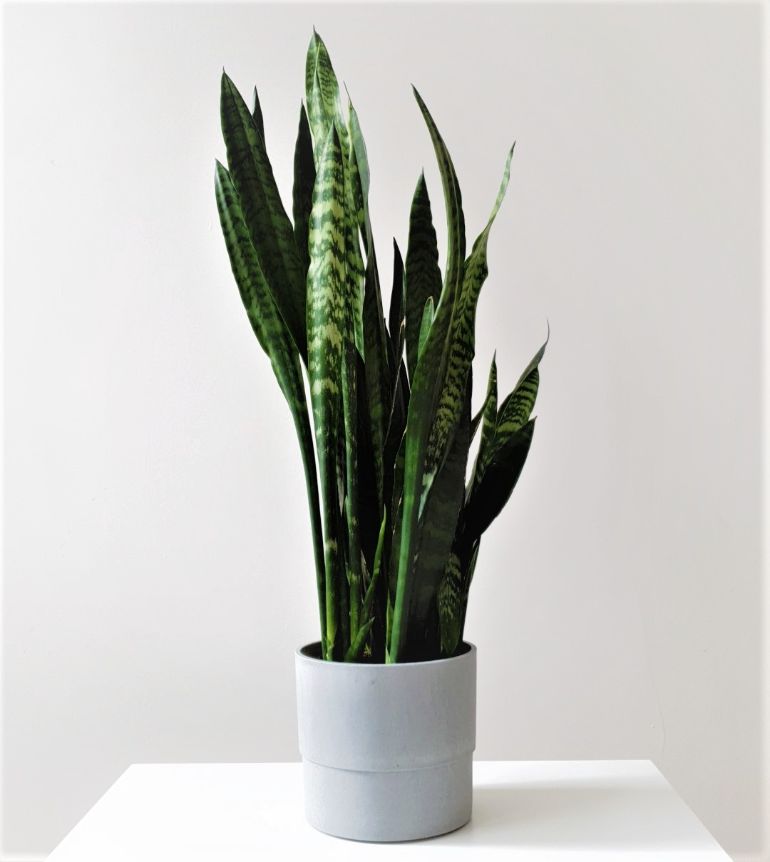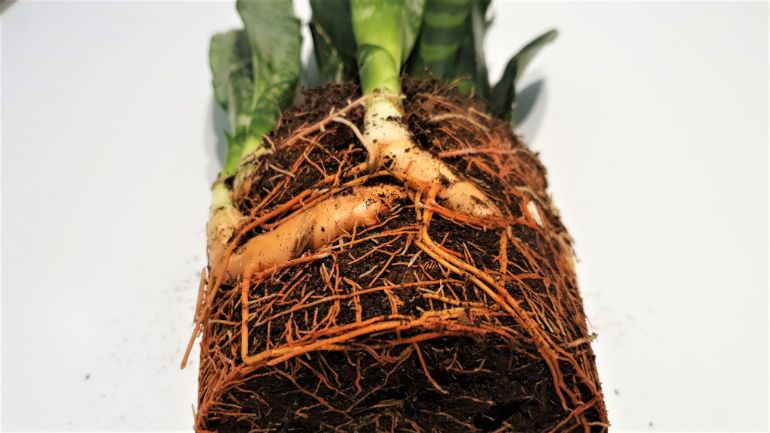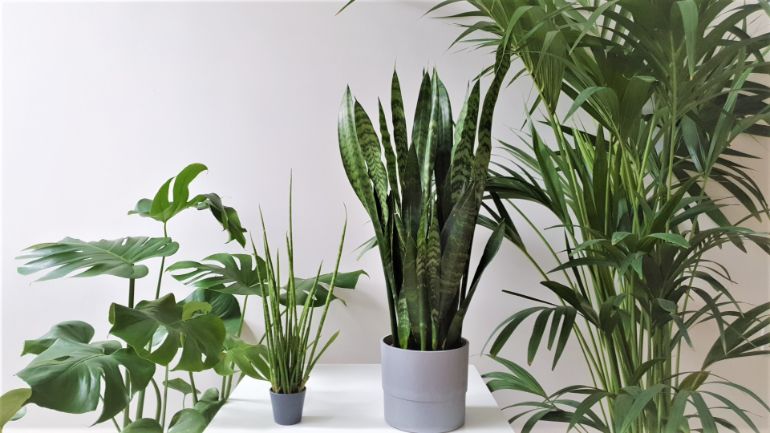If you’ve noticed that your Snake Plant isn’t growing, you may be wondering what’s happening. Whilst not particularly fast-growing houseplants, they should grow new leaves and stretch upwards over time. This article will help you work out why your Snake Plant is not growing, and make the changes required to get it thriving again.
The most common reasons for a Snake Plant not growing are lack of light or water. Damage from overwatering, pests, or disease can also prevent your Snake Plant from growing. Check your plant carefully for signs of stress, increase lighting, and monitor the plant’s water needs every few days.
What To Do If Your Snake Plant Is Not Growing
There are two main reasons why Snake Plants stop growing;
- The plant is lacking one or more of the essential conditions to promote healthy growth, including light, water, or nutrients.
- Your Snake Plant has stopped growing due to stress caused by a problem, such as pests, disease, temperature stress, acclimation, or overwatering.
With so many potential causes, it’s important to do a little detective work to find out what the issue is before trying to fix your plant. It’s usually fairly easy to work out what the issue is, and then fixing most problems is fairly straightforward.
The rest of this article will walk you through the common reasons for a Snake Plant not growing, and answer a number of specific questions, to help you get your plant on the right track.
How Do I Know If My Snake Plant Is Healthy?
The first thing to do is a quick inspection of your plant and the conditions it is growing in.
- Look for stiff, upright leaves, with minimal brown or yellow discoloration. Don’t worry if the leaves aren’t growing completely straight up, as this doesn’t always mean your plant isn’t healthy.
- Drooping leaves are often a sign of root rot, caused by overwatering.
- Check for any signs of pests or disease. Inspect both sides of the leaves and right down to the soil.
- Look for roots growing out of the drainage holes, which may indicate that your plant is rootbound, restricting growth.
Do Snake Plants Grow Slowly?
Snake Plants are relatively slow growing houseplants. Their leaves usually grow by 1-3 inches per month, depending on the suitability of their growing conditions. They produce 2-4 new leaves at a time from their rhizome during the growing season and can easily grow 6-10 new leaves in a year.
Snake Plants will typically spread by about 1-2 inches per year and will need to be repotted every 2-3 years once rootbound to prevent their growth being restricted.
It is normal for snake Plants not to produce any new growth over the winter months, but they should start to produce new leaves and increase the size of existing leaves from early spring onwards.
Causes Of A Snake Plant Not Growing
Let’s run through each of the common causes of a Snake Plant not growing to help you fix any major issues.

Lack Of Light
Whilst Snake Plants are often sold as “low light” plants, they always do much better in bright, indirect light. Snake Plants can survive for a long time in low light conditions, and often won’t suffer too badly as long as they are not overwatered.
However, without adequate light, your Snake Plant will stubbornly refuse to grow – there simply isn’t enough light energy for the plant to produce new growth.
Snake Plants do best when grown in bright, indirect light indoors, but can tolerate a few hours of direct sunlight, particularly in the early morning and late afternoon. A quick way to tell whether your Snake Plant is getting enough light is to hold your hand up just in front of a wall or floor near your Snake Plant. If your hand doesn’t make a fairly clear shadow against the surface, then the available light is too low.
Alternatively, you can use the light sensor on your phone to check how much light your plant is getting. There are various free light meter apps available on the Apple and Android stores you can use to get a quick reading. Bright indirect light is approx 10,000–20,000 lux (1,000–2,000 foot-candles).
You will likely be surprised just how bright this is. checking this will enable you to move your Snake Plant to a more appropriate location, and your Snake Plant should respond by producing new growth within a few weeks. You can read more info about light requirements for houseplants here.
Underwatering
Whilst very tolerant to drought, Snake Plants will reduce their growth rate dramatically when not given enough water. I normally water my Snake Plants once the soil is almost completely dry, but you will rarely see any signs of distress from a Snake Plant until many weeks or months after the soil has dried out.
Look for dry soil, curling leaves, brown leaf tips, and lack of growth as the main symptoms of underwatering.
It is a good idea to check the soil every few days by digging a finger into it to test for dampness, to make sure you water your plant when it needs it. I also like to lift the pot to check the weight, as dry soil is much lighter than wet soil, and you very quickly get a feel for how light the pot should be before it needs to be watered.
Overwatering
The other side of the watering coin is overwatering, which can also stop your Snake Plant from growing. Unfortunately, overwatering stops the plant from growing by inducing root rot, and often killing the plant in the process. Always err on the side of caution when watering your Snake Plant, as underwatering is much less harmful to your plant.
If the leaves are drooping and turning yellow, you need to act quickly to stand a chance of saving your plant. You’ll need to follow these steps to fix your plant.
- Remove your Snake Plant gently from the pot.
- Inspect the roots for any signs of root rot. Rotten roots will be brown/black, mushy, fragile, and smelly.
- If root rot is present, gently prune off all affected roots with sterile pruning shears.
- Remove most of the soil from around the remaining roots by hand, then wash the remaining soil off with water. This is important as rot-causing pathogens are likely to remain in the soil.
- Treat the healthy roots with a dilute hydrogen peroxide solution (Optional, but it does help)
- Repot your Snake Plant in fresh, appropriate soil, in a pot with plenty of drainage holes.
- Provide moderate light, water, temperatures, and humidity. Avoid any extremes of your Snake Plant’s preferred conditions.
- Your Snake Plant will likely spend several months developing new, healthy roots, but will eventually start growing and can make a full recovery.
Becoming Rootbound
Snake Plants will only produce new growth if they have sufficient, healthy roots to support the new plant. If your plant has filled the pot with roots, this may inhibit the plant from producing new growth.
Although Snake Plants like to keep their foliage tightly packed, a rootbound Snake Plant will also reach the point where there is simply no more room for new foliage.
It is not essential to repot a rootbound Snake Plant, and in fact, many people like to keep them rootbound to restrict their growth and keep them to their desired size. This is one of the reasons why I have not yet repotted my plant.
If you would like to promote new growth on your Snake Plant, repot your plant into a pot that is 1-2 inches bigger than the current pot. It’s tempting to put your plant in a much bigger pot, but this can increase the risk of overwatering. The significant increase in the quantity of soil in the pot will take a lot longer to dry out, and it will take some time for roots to grow into the new soil. You can learn the step-by-step process for repotting a rootbound plant in this article.

Acclimation
Most plants need a period of adjustment when you first bring them home. Snake Plants are normally grown in optimal conditions by the grower, and the conditions in your home are unlikely to be quite as good. There is a reasonable chance that your Snake Plant will stop growing for a month or two initially until it adapts to the new conditions.
If your plant looks well and you are providing all the basic care conditions it needs, then simply wait a while, and you should see new growth before too long.
Lack Of Fertilizer
Snake plants aren’t heavy-feeding houseplants, but a lack of nutrients can really slow down, or even stop new growth. I like to fertilize my Snake Plants every 2-3 months during the growing season. I use a water-soluble, balanced fertilizer made up at half the recommended strength.
The options for fertilizing your plant are endless. Whether you want to add compost to the potting mix, use natural products like worm castings or compost tea, or choose an off-the-shelf synthetic fertilizer, the main goal is to provide an adequate supply of the main nutrients your Snake Plant needs to grow.
Bear in mind that more fertilizer is not better! Whilst a little fertilizer will help your Snake Plant grow quickly, too much can damage the leaves and roots, and even stop the plant from growing completely. In fact, too much fertilizer is a much more likely cause of your Snake Plant not growing than too little.
Watch for signs of fertilizer salts building up on the soil surface, or your plant developing brown patches or tips on the leaves, despite other care requirements being met. If you think you may have fertilized too much, flush the soil with copious quantities of water to wash the excess out. Avoid fertilizing for at least 6 months if you think overfertilizing has been the cause of your Snake Plant not growing.
Pests And Disease
Both pests and disease can cause significant stress for your plant, and halt growth completely. The majority of diseases that Snake Plants experience are caused by overwatering, so getting this aspect of care right is the key to preventing problems.
Mealybugs and scale seem to be particularly fond of Snake Plants and the damage that they cause can have a big impact on their growth and health. The best way to deal with all pests is to check your snake plant often and treat promptly.
Look carefully on both sides of the leaves, right down to where they emerge from the soil for any signs of pests. You can read this article to learn more about identifying, treating, and preventing houseplant pests.
If you detect any pests, follow these steps to treat the problem;
- Immediately isolate your plant from all your other houseplants.
- Manually remove as many of the pests as possible, either by wiping them off with a cloth or washing them off with a spray of water from a shower head or hose.
- Spray the plant thoroughly with a treatment such as dilute hydrogen peroxide, neem oil, or isopropyl alcohol spray.
- Repeat the treatment every 5-7 days for 3-4 weeks until you are entirely sure all pests have been dealt with.
- You can move your plant back to its normal spot once you are confident it has been properly treated.
A significant pest infestation will usually lead to your Snake Plant not growing, and it can take a few months after treating the plant before growth resumes. Have patience and you are likely to be rewarded.
How Can I Make My Snake Plant Grow Faster?
The way to get your Snake Plant to grow as quickly as possible is to optimize the care conditions, and avoid any sources of stress. In particularly, providing plenty of light, adequate, but not excessive water, and a little fertilizer 2-3 times per year are the best ways to ensure growth is as quick as possible.
It is normal for a Snake Plant to stop growing in winter, as light levels will be insufficient to promote new growth. However, if you want to keep your Snake Plant growing year-round, you could consider using a grow light to boost light levels.
I normally use a number of grow lights for my houseplants during the winter, mainly to prevent them from deteriorating over the winter months, but also to encourage some new growth.
Why Is My Snake Plant Not Growing Straight Up?
The most common cause of a Snake Plant not growing straight up is that the light is coming from the side, and the plant is growing towards the light. This will cause the leaves to curve towards the light source over time. You can reduce the impact of this by rotating your plant every time you water it to keep the leaves growing as straight as possible.
Various other issues can cause the leaves to curve or droop, including pests, diseases, and watering problems. Make sure to examine your plant carefully, and have a think about the conditions your plant has been growing in.
Last Word
I hope this article has helped you find out why your Snake Plant isn’t growing. Whilst it’s always disappointing when a plant isn’t growing as well as it should, it’s a great opportunity to learn more about what makes your plants happy. Hopefully, nursing your Snake Plant back to health will help you prevent issues with lots of your other houseplants.
If you’d like to go from brown thumb to houseplant expert, you should check out my book, “Houseplants Made Easy”. I make it really simple for you to grow beautiful, healthy houseplants that will thrive year after year.
You should also check out some of my other articles, to learn more about keeping all your houseplants healthy.

